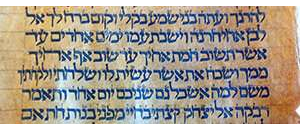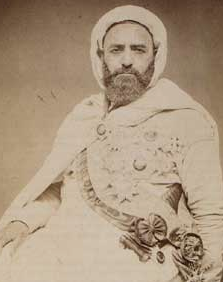
What do the University of Kansas and a French chateau have in common? The first possesses part of a torn Algerian scroll. The second, residence of the French Duc d’Orleans, was for a long time home to the other half of the same scroll. Here is the amazing Mosaic saga of how the two halves were re-united by a University of Kansas professor of religious studies, Paul Mirecki (with thanks: Lily, Noga):
Fragment of the Kansas scroll
But who did the ripping and why they did it developed into the most interesting aspect of the saga.
In 1840, the scroll was intact and residing at a synagogue in the Algerian city of Medea. The Ottoman Empire controlled Algeria at the time. Then France invaded. Meanwhile, a local populace of Muslim extremists launched a pogrom against the Jewish community. Arab religious and military leader Abd-el-Kader intervened in hopes of preventing bloodshed, evacuating members of the Jewish community. But he couldn’t protect their property. As synagogues were looted, the item was taken. (This was likely done by people who didn’t even speak Hebrew and merely hoped to sell it. By ripping it, they had “two scrolls” and could double their profits.)
Enter Henri d”Orléans, the Duke of Aumale. The son of the last king of France and governor-general during the French invasion of Algeria, the duke lived in Chateau Chantilly.
The Emir Abdel Kader
The duke brought it back home, where it remains in the vast collection of antiquities he eventually donated to the Institut de France. KU acquired its half of the scroll thanks to Alpha Owens. A KU student in the early 1900s, she went on to earn her doctorate from Johns Hopkins University. A woman of wealth, Owens traveled throughout Europe and Latin America “collecting valuable realia material for use in modern language teaching,” according to a 1952 interview. Mirecki thinks she evidently came across the document for sale at a market (or possibly a bookstore) when visiting France, as she had been a student at Sorbonne University. Owens bequeathed it to KU when she died in 1965.
How did the Jews fare in Algeria during this period? This Cairn.info article gives the background to the scroll story: the 19th century war in Algeria between the French and the rebellious western tribes led by the Emir Abdel Kader. Before Abdel Kader surrendered in 1847, several towns in Algeria changed hands: one in particular, Mascara, was the scene of a bloody massacre of those Jews who had not fled. As the Arabs had taken their revenge on the Jews, the French were welcomed as liberators.
“In the long and bloody war between this one to France, which was the fate of the Jews of western Algeria? Far from freeing the Jews taxes, chores and vexatious measures that were their lot, the emir did not hesitate to strengthen, especially after the resumption of hostilities in 1835 [5] [5]Claude Martin, Algerian Israelites from 1830 to 1902, Paris, …. Indeed, Abd el-Kader then needs the Jews who play a leading economic and financial role in the region: besides the exceptional contributions he imposes [6] [6]The tribes refusing to pay the tax, Jews and Beni-M’Zabs in …He uses Jewish middlemen for trade and supply of arms. Jews still make tents for his troops and, no doubt, are charged with coining money, an activity prohibited to Muslims, in the city of Tagdempt [7] [7]Marcel Emerit, Algeria to the Time of Abd-el-Kader, op. cit., …. Jews, like other sections of the population, are thus forced to contribute to the war effort in all places controlled by Abd el-Kader. In addition, between 1835 and the final victory of France over the emir in 1847, several medium-sized cities, such as Tlemcen and Mascara, pass into the hands of the French, before being taken over by Abd el-Kader. The situation of Jews, Couloughlis and Arabs rallied to the French becomes critical. The civilian population is caught in the heat of battle and the Jews, suspected of sympathy for France, are massacred by the Arabs. This phenomenon can be measured through the example of the Jewish population of Mascara, which is directly affected by the violence of the war.”
Read article in full (French)



Leave a Reply